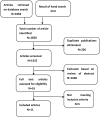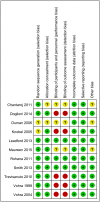Efficacy and Safety of Plastic Wrap for Prevention of Hypothermia after Birth and during NICU in Preterm Infants: A Systematic Review and Meta-Analysis
- PMID: 27281027
- PMCID: PMC4900561
- DOI: 10.1371/journal.pone.0156960
Efficacy and Safety of Plastic Wrap for Prevention of Hypothermia after Birth and during NICU in Preterm Infants: A Systematic Review and Meta-Analysis
Abstract
Objective: This meta-analysis aimed to investigate the efficacy and safety of plastic wrap applied after birth and during NICU in preterm infants for prevention of heat loss in preterm infants.
Study methods: The Medline (1950 to August 2015), the Cochrane Central Register of Controlled Trials (CENTRAL, Issue 7, 2015), CINAHL (1982 to August 2015) and the Embase (1974 to August 2015) databases were searched for randomized controlled trials (RCTs) or quasi-RCTs with main outcomes related to the core temperature (baseline temperature and/or post-stabilization temperature), hypothermia, mortality rate and hyperthermia.
Result: The included studies were of low to moderate quality. Compared with unwrapped infants, plastic wrap was associated with a significantly higher baseline temperature and post-stabilization temperature both in infants < 28 weeks of gestation (mean difference [MD] = 0.62, 95% CI 0.38 to 0.85; MD = 0.41, 95% CI 0.33 to 0.50, respectively), and in infants between 28 to 34 weeks of gestation (MD = 0.54, 95% CI 0.21 to 0.87; MD = 0.64, 95% CI 0.45 to 0.82, respectively). Use of plastic wrap was associated with lower incidence of hypothermia (relative risk [RR] = 0.70, 95% CI 0.63 to 0.78). However, use of plastic wrap in preterm infants was not associated with decrease in mortality (RR: 0.88, 95% CI 0.70 to 1.12, P = 0.31). Incidence of hyperthermia was significantly higher in the plastic wrap group as compared to that in the control group (RR = 2.55, 95% CI: 1.56 to 4.15, P = 0.0002). Hyperthermia in the plastic wrap group was resolved within one or two hours after unwrapping the babies.
Conclusion: Plastic wrap can be considered an effective and safe additional intervention to prevent hypothermia in preterm infants. However, its cost-effectiveness and long-term effect on mortality needs to be ascertained by conducting well-designed studies with longer follow-up period.
Conflict of interest statement
Figures









Similar articles
-
Interventions to prevent hypothermia at birth in preterm and/or low birth weight infants.Cochrane Database Syst Rev. 2018 Feb 12;2(2):CD004210. doi: 10.1002/14651858.CD004210.pub5. Cochrane Database Syst Rev. 2018. PMID: 29431872 Free PMC article.
-
Interventions to prevent hypothermia at birth in preterm and/or low birthweight babies.Cochrane Database Syst Rev. 2005 Jan 25;(1):CD004210. doi: 10.1002/14651858.CD004210.pub2. Cochrane Database Syst Rev. 2005. Update in: Cochrane Database Syst Rev. 2008 Jan 23;(1):CD004210. doi: 10.1002/14651858.CD004210.pub3. PMID: 15674932 Updated.
-
Interventions to prevent hypothermia at birth in preterm and/or low birthweight infants.Cochrane Database Syst Rev. 2008 Jan 23;(1):CD004210. doi: 10.1002/14651858.CD004210.pub3. Cochrane Database Syst Rev. 2008. Update in: Cochrane Database Syst Rev. 2010 Mar 17;(3):CD004210. doi: 10.1002/14651858.CD004210.pub4. PMID: 18254039 Updated.
-
Interventions to prevent hypothermia at birth in preterm and/or low birthweight infants.Cochrane Database Syst Rev. 2010 Mar 17;(3):CD004210. doi: 10.1002/14651858.CD004210.pub4. Cochrane Database Syst Rev. 2010. Update in: Cochrane Database Syst Rev. 2018 Feb 12;2:CD004210. doi: 10.1002/14651858.CD004210.pub5. PMID: 20238329 Updated.
-
Delivery Room Interventions for Hypothermia in Preterm Neonates: A Systematic Review and Network Meta-analysis.JAMA Pediatr. 2021 Sep 1;175(9):e210775. doi: 10.1001/jamapediatrics.2021.0775. Epub 2021 Sep 7. JAMA Pediatr. 2021. PMID: 34028513 Free PMC article.
Cited by
-
The knowledge, awareness, attitude and motivational analysis of plastic waste and household perspective in Malaysia.Environ Sci Pollut Res Int. 2017 Jan;24(3):2304-2315. doi: 10.1007/s11356-016-7942-0. Epub 2016 Nov 3. Environ Sci Pollut Res Int. 2017. PMID: 27812970
-
Neuroprotection from acute brain injury in preterm infants.Paediatr Child Health. 2019 Jul;24(4):276-290. doi: 10.1093/pch/pxz056. Epub 2019 Jun 21. Paediatr Child Health. 2019. PMID: 31239818 Free PMC article. Review.
-
Hypothermia in preterm infants admitted to low-resource neonatal units in northern Nigeria: an observational study of occurrence and risk factors.BMC Pediatr. 2024 Jul 24;24(1):471. doi: 10.1186/s12887-024-04960-3. BMC Pediatr. 2024. PMID: 39049058 Free PMC article.
-
Perioperative care of neonates with critical pulmonary stenosis: Case report.Medicine (Baltimore). 2024 Feb 23;103(8):e37203. doi: 10.1097/MD.0000000000037203. Medicine (Baltimore). 2024. PMID: 38394548 Free PMC article.
-
Interventions to prevent hypothermia at birth in preterm and/or low birth weight infants.Cochrane Database Syst Rev. 2018 Feb 12;2(2):CD004210. doi: 10.1002/14651858.CD004210.pub5. Cochrane Database Syst Rev. 2018. PMID: 29431872 Free PMC article.
References
-
- Flamant C, Gascoin G. [Short-term outcome and small for gestational age newborn management]. J Gynecol Obstet Biol Reprod (Paris).2013; 42: 985–995. - PubMed
-
- Hazan J, Maag U, Chessex P. Association between hypothermia and mortality rate of premature infants—revisited. Am J Obstet Gynecol.1991; 164: 111–112. - PubMed
-
- Mannan MA, Jahan N, Dey SK, Uddin MF, Ahmed S. Maternal and foetal risk factor and complication with immediate outcome during hospital stay of very low birth weight babies. Mymensingh Med J.2012; 21: 639–647. - PubMed
Publication types
MeSH terms
Substances
LinkOut - more resources
Full Text Sources
Other Literature Sources
Medical

